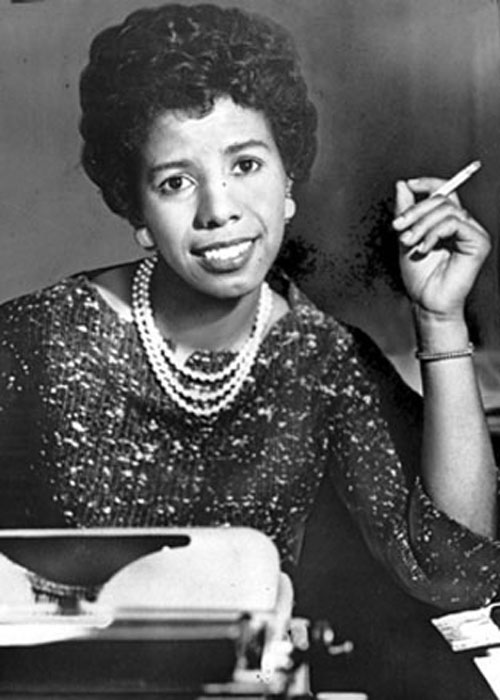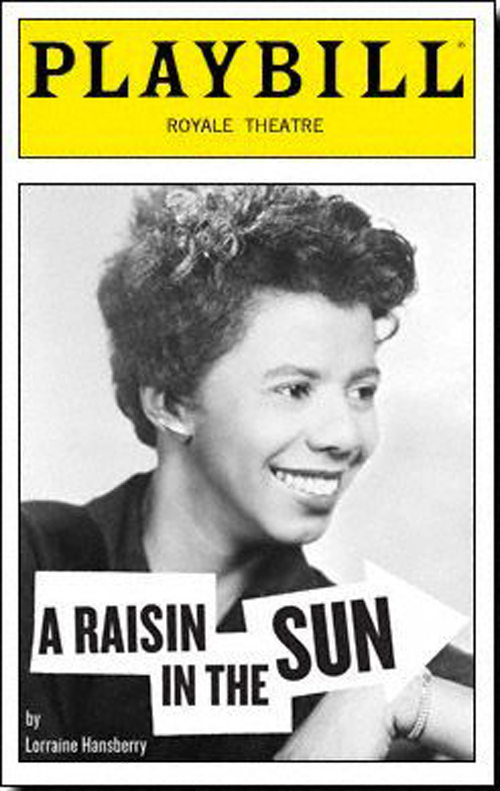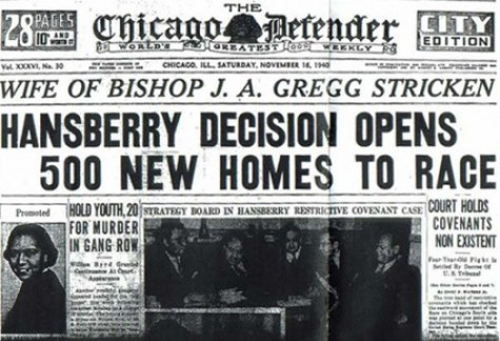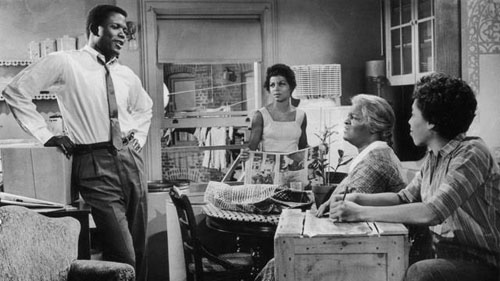BLACK HISTORY MONTH LESSON PLAN: How Lorraine Hainsberry's work and life expose how ridiculous the corporate 'school reform,' Common Core and its racist supporters -- Black and White -- really look in the spotlights and stage lights of history
Anyone who has read, seen, taught and loves the archtypal Chicago story "A Raisin in the Sun" knows immediately that any 20th (and some 21st) Century Black History Month curriculum centered in Chicago has to include Lorraine Hansberry. But few might think, at first, about how Hansberry -- both life and work (as so many other Chicago artists) -- shows how ridiculous the pretensions of "Common Core" are. No matter how loud the propagandists, billionaire backers, and supporters of the Common Core pontificate, President Obama's signal education move is still poised for the satirical pen of the right playwright, lyricist, or poet. (Already as this is written, several states, as reported in the Chicago Tribune, have been "rebranding" Common Core, as if a baptismal rejiggering can erase idiocy...).
 Lorriane Hansberry with her signature cigarette and at her ever present typewriter.And central to the ugliness of Common Core is its racism. For every John King, Barack Obama or Corey Booker preaching some version of social Darwinism (and supporting Race To The Top, charter school attacks on real public schools and Common Core), there are thousands of young, gifted and black children every day experiencing the love of literature and imaginative play. And this is often thanks to the imaginative writings that first inspired young Lorraine Hansberry and then brought her brief life to making one of the more amazing additions to it, the signal American drama "A Raisin in the Sun."
Lorriane Hansberry with her signature cigarette and at her ever present typewriter.And central to the ugliness of Common Core is its racism. For every John King, Barack Obama or Corey Booker preaching some version of social Darwinism (and supporting Race To The Top, charter school attacks on real public schools and Common Core), there are thousands of young, gifted and black children every day experiencing the love of literature and imaginative play. And this is often thanks to the imaginative writings that first inspired young Lorraine Hansberry and then brought her brief life to making one of the more amazing additions to it, the signal American drama "A Raisin in the Sun."
To put it another way and in the context of Chicago history. Can anyone take seriously the demand for INFORMATIONAL TEXT by claiming that the Supreme Court decision in Hansberry, or even Lorraine Hansberry's own autobiography, be posed in opposition to the play "A Raisin in the Sun"?
Only the current addled crowd of Harvardistas, Ivy League poseurs, and Harvard adulators could possible have raised an overrated and overpaid and overimpressed-with-himself guy like David Coleman (now the $750,000-a-year chief of the College Board and proud architect of Common Core), teams with an even less admirable mope like Arne Duncan to the level of leaders of public education in the USA. But in early 2014, these guys are dictating how the next generation of Black children will not allowed to be "Young, Gifted, and Black" -- at least not imaginative enough to turn what could have been a family tragedy into one of the most gripping dramas of the 20th Century.
The Greatest Generation of Black artists that emerged after World War I (famed in part as the "Harlem Renaissance" but with many of their more poignant working class roots in Chicago's South Side) and continued through both Great Migrations (post World War I and even more post World War II) knew better than to denigrate, slander and libel the public schools. Until the current generation -- beneficiaries of all the work of the rest of us -- the public schools were known to be central to the life and future of Black Chicago, not some profit center to be denigrated and attacked. Throughout the era of the Great Migrations, the public schools and there teachers were one of the welcoming centers in Chicago and other Northern cities.
The creative leaders of Black America's Greatest Generation also knew that their teachers in those (mostly segregate) Northern schools were among the true "Best and the Brightest". No one among Lorraine Hansberry's classmates would have thought to denigrate those teachers -- even if the teachers were "only" educated at Chicago Teachers College (currently, Chicago State University) or (almost better) at one of the "Historically Black Colleges" of the South.
 When Lorraine Hansberry's play "A Raisin In The Sun" opened on Broadway's Royale Theater, the mostly white audiences that came to its first run were often stunned into silence -- and massive applause. The epic Chicago story about the struggles of the Younger family had to achieve the power of fiction to do their work for the average audience of the 1950s. Lorraine Hansberry, Richard Wright, Langston Hughes, James Baldwin, the patriarch W.E.B. DuBois and hundreds of others, most not so well known, joined with their public schools and public school teachers. They paved the easy street down which Barack Obama, Michelle Obama, Corey Booker, Adrian Fenty and others marched into Harvard, wealth, fame and power -- and then betrayed those who brought them there.
When Lorraine Hansberry's play "A Raisin In The Sun" opened on Broadway's Royale Theater, the mostly white audiences that came to its first run were often stunned into silence -- and massive applause. The epic Chicago story about the struggles of the Younger family had to achieve the power of fiction to do their work for the average audience of the 1950s. Lorraine Hansberry, Richard Wright, Langston Hughes, James Baldwin, the patriarch W.E.B. DuBois and hundreds of others, most not so well known, joined with their public schools and public school teachers. They paved the easy street down which Barack Obama, Michelle Obama, Corey Booker, Adrian Fenty and others marched into Harvard, wealth, fame and power -- and then betrayed those who brought them there.
Let's just take one example of the racist reductionism of the Common Core.
Can anyone argue seriously that the "informational texts" that are readily available (at least now in the age of the Internet) regarding the "topic" of "A Raisin In The Sun" can really bring children and adults to an "understanding" of racism in Chicago like the play that Chicagoan Lorraine Hansberry actually gifted us with?
The one scene between the Arne Duncan character and the Younger family in "A Raison In The Sun" blasts the very thought away.
In less than five minutes on stage, in a work of the imagination, the playwright brings to an emotional peak the whole "point" of the play -- and its era. The Younger family is going to move into a "better" community because they know that its schools services and other realities will be "better" for the children.
 While the Chicago Defender knew the importance of the U.S. Supreme Court's "Hansberry" decision, most of Chicago's white (and then, racist) press realized that what the Supreme Court orders for Chicago Chicago can undo. Thus, in the late 1970s, Substance could find property owners on Chicago's Northwest Side still honoring restrictive covenants that were supposedly declared unconstitutional 30 years earlier -- and Chicago had become more segregated than it was when her father's fight inspired Lorraine Hansberry's play.It's really as simple, for Lorraine Hansberry as it was for the Robinson family when they became among the first Black families to move into the Bryn Mawr school district in Chicago -- only to find that the city's owners and leaders had conspired to block bust and racially wreck the dreams of three generations for what would have been peaceful equality. But nobody who knows the work of Lorraine Hansberry and her generation could imagine any of them -- or any of the fictional characters they created -- betraying their roots as completely as Michelle Robinson, now the First Lady, did when she took the "First Ladies" of NATO back to her "old neighborhood" and instead of taken them to the real public school whose teachers, coaches and others nurtured her and her family -- took the leaders of the so-called "Free World" to a charter school nearby instead. And with a straight face!
While the Chicago Defender knew the importance of the U.S. Supreme Court's "Hansberry" decision, most of Chicago's white (and then, racist) press realized that what the Supreme Court orders for Chicago Chicago can undo. Thus, in the late 1970s, Substance could find property owners on Chicago's Northwest Side still honoring restrictive covenants that were supposedly declared unconstitutional 30 years earlier -- and Chicago had become more segregated than it was when her father's fight inspired Lorraine Hansberry's play.It's really as simple, for Lorraine Hansberry as it was for the Robinson family when they became among the first Black families to move into the Bryn Mawr school district in Chicago -- only to find that the city's owners and leaders had conspired to block bust and racially wreck the dreams of three generations for what would have been peaceful equality. But nobody who knows the work of Lorraine Hansberry and her generation could imagine any of them -- or any of the fictional characters they created -- betraying their roots as completely as Michelle Robinson, now the First Lady, did when she took the "First Ladies" of NATO back to her "old neighborhood" and instead of taken them to the real public school whose teachers, coaches and others nurtured her and her family -- took the leaders of the so-called "Free World" to a charter school nearby instead. And with a straight face!
A CHICAGO LIFE CELEBRATED
Lorraine Hansberry was one of a generation of progressive Black intellectuals, organizers and activists who brought the words, music, and thinking of the people to their own communities and to the USA � even when many people were not listening or watching.
She was the youngest of four children of Carl Augustus Hansberry. Her father was a successful real-estate broker, and Nannie Louise Perry who was a public school teacher. As most Black people in Chicago learned, the strangulation and then slow block-by-block expansion of the �Black Belt� (depicted most dramatically by Richard Wright in the chase scenes in �Native Son�) was the �Chicago Way� to segregate. The plan was not to let Black people and white people, especially working people, live together. Divide and conquer was the master plan in the nation's third largest city from the time of the first Great Migration after the First World War. The plan came from the suites to pit working class Black and white people against one another.
The enforcement for segregation in Chicago and across the North was not the Ku Klun Klan (usually) but the real estate brokers, political leaders, and power brokers who provided the smiles and reaped the profits from segregation and block busting along the �border.� Their Black adjunct reaped some profits from a captive market and an easily centralized and controlled electorate.
On the eve of World War II, the �border� between Black Chicago and the rest of the city was near Englewood. In 1938, Lorriane Hansberry�s father bought a house in the Washington Park Subdivision of the South Side of Chicago. By purchasing a home for his family, Carl Hansberry broke a restrictive covenant and incurred the wrath of their white neighbors. The infamous restrictive covenant, placed by law into every real estate transaction in Chicago (and which became a model for the North), forced the buyer or renter to agree not to sell or rent to certain groups -- almost always "Negros," followed often by Jews and Asiatics. The words of the restrictive covenants were written into millions of sale and lease agreements over nearly a quarter of a century -- until challenged by Lorraine Hansberry's Dad all the way to the United States Supreme Court.
The white peoples� legal efforts to force the Hansberrys out of their �community� culminated in the U.S. Supreme Court's 1940 decision in Hansberry v. Lee. The Supreme Court held the restrictive covenant in the case contestable, though not inherently invalid.
Carl Hansberry was also a backer of the Urban League and NAACP in Chicago. Both of Lorraine Hansberry�s parents were active in the Chicago Republican Party. At the time, many Black people in Chicago were still Republicans, not only because of the memory of the Republican Party as the Party of Lincoln and Emancipation, but also because the Democratic Party, despite the pretensions of the New Deal, was also the party of the kinds of segregation faced by the Hansberries in the North, and Lynch Law and the KKK in the south. Carl Hansberry died in 1946, when his daughter was fifteen years old; "American racism helped kill him", she later said.
�The Hansberrys were routinely visited by prominent Black intellectuals, including W.E.B. DuBois and Paul Robeson,� on history notes. �Carl Hansberry's brother, William Leo Hansberry, founded the African Civilization section of the history department at Howard University. Lorraine was taught:.. Above all, there were two things which were never to be betrayed: the family and the race.�
Those two themes became memorialized forever in her play �A Raison in The Sun.�
While children in public schools might be forced, under �Common Core�, to read the non-fiction text of the Hansberry Supreme Court case, generations of children have read and often cried during �A Raisin in the Sun.� Althugh few Chicago Black children were able to see the play when it broke new ground on Broadway in New York, the Hollywood movie, starring Sidney Poitier, brought Lorraine Hansberry�s story into thousands of classrooms and millions of lives.
Public education was central to her life. Lorraine Hansberry graduated from Chicago�s Betsy Ross Elementary in 1944 and from Englewood High School in 1948. She then attended the University of Wisconsin�Madison, where she immediately became politically active and integrated a dormitory. She worked on Henry A. Wallace's presidential campaign in 1948, despite her mother's disapproval and then spent the summer of 1949 in Mexico, studying painting in at the University of Guadalajara.
She decided in 1950 to leave the Midwest and pursue her career as a writer in New York City, where she attended The New School. She moved to Harlem in 1951 and became involved in activist struggles such as the fight against evictions.
In 1951, she joined the staff of the black newspaper Freedom, edited by Louis E. Burnham and published by Paul Robeson. At Freedom, she worked with W. E. B. DuBois, whose office was in the same building, and other Black Pan-Africanists. At the newspaper, she worked as "subscription clerk, receptionist, typist and editorial assistant" in addition to writing news articles and editorials.
One of her first reports covered the "Sojourners for Truth and Justice" convened in Washington, D.C., by Mary Church Terrell. She traveled to Georgia to cover the case of Willie McGee, and was inspired to write the poem "Lynchsong" about his case.
 Sidney Poitier as Walter Lee in the Hollywood production of the Lorraine Hansberry play "A Raisin in the Sun." Millions of public school children have read the play and understood the story thanks in part to the Hollywood production, while few could afford to have seen it on Broadway during its 1959 run.She worked not only on the US civil rights movement, but also on global struggles against colonialism and imperialism. Hansberry wrote in support of the Mau Mau Uprising in Kenya, criticizing the mainstream press for its biased coverage. Had she lives long enough, she doubtless would have devoted some of her journalism talents to covering the murder of the leader of Congo independence, Patrice Lumumba, by the American CIA and thugs in the pay of the USA and Belgium.
Sidney Poitier as Walter Lee in the Hollywood production of the Lorraine Hansberry play "A Raisin in the Sun." Millions of public school children have read the play and understood the story thanks in part to the Hollywood production, while few could afford to have seen it on Broadway during its 1959 run.She worked not only on the US civil rights movement, but also on global struggles against colonialism and imperialism. Hansberry wrote in support of the Mau Mau Uprising in Kenya, criticizing the mainstream press for its biased coverage. Had she lives long enough, she doubtless would have devoted some of her journalism talents to covering the murder of the leader of Congo independence, Patrice Lumumba, by the American CIA and thugs in the pay of the USA and Belgium.
"Hansberry often clarified these global struggles by explaining them in terms of female participants," one history states. "She was particularly interested in the situation of Egypt, 'the traditional Islamic 'cradle of civilization,' where women had led one of the most important fights anywhere for the equality of their sex.'" Her affiliation with the older generation of Black geniuses led her into international work as well. In 1952, Hansberry attended a peace conference in Montevideo, Uruguay, in place of Paul Robeson, who had been denied travel rights by the State Department. Buy then, Robeson had survived a lynch mob organized in part by the FBI and other officials in Peeksill New York but was barred from his international career by McCarthyism, whose anti-Communist roots stretched back much further than the days of the Senator from Wisconsin.
RAISIN IN THE SUN
Opening on March 11, 1959, Raisin in the Sun becoming the first play written by an African-American woman to be produced on Broadway. The 29-year-old author became the youngest American playwright and only the fifth woman to receive the New York Drama Critics Circle Award for Best Play. Over the next two years, Raisin in the Siun was translated into 35 languages and being performed all over the world.
Hansberry wrote two screenplays of Raisin, both of which were rejected as "controversial" by Columbia Pictures. Commissioned by NBC in 1960 to create a television program about slavery, Hansberry wrote "The Drinking Gourd," but the censorship and racism of the era also barred that from the public. This script was called "superb" but also rejected.
In 1961, she was ready to return to Chicago to continue her art. Hansberry was set to replace Vinnette Carroll as the director of the musical, Kicks and Co, after its try-out at Chicago's McCormick Place. It was written by Oscar Brown, Jr. and featured an interracial cast including Lonnie Sattin, Nichelle Nichols, Vi Velasco, Al Freeman, Jr., Zabeth Wilde and Burgess Meredith in the title role of Mr. Kicks. A satire involving miscegenation, the $400,000 production was co-produced by her husband Robert Nemiroff; despite a warm reception in Chicago, the show never made it to Broadway.
In 1963, she was diagnosed with pancreatic cancer. She underwent two operations, on June 24 and August 2. Neither was successful in removing the cancer. On March 10, 1964, Hansberry and Nemiroff divorced but continued to work together. While many of her other writings were published in her lifetime�essays, articles, and the text for the SNCC book "The Movement" �the only other play given a contemporary production was "The Sign in Sidney Brustein's Window." The Sign in Sidney Brustein's Window ran for 101 performances on Broadway and closed the night she died.


By: BrandonBag
remedies psoriasis
herbal libido enhancer https://forums.dieviete.lv/profils/127605/forum/ rosacea herbal remedies